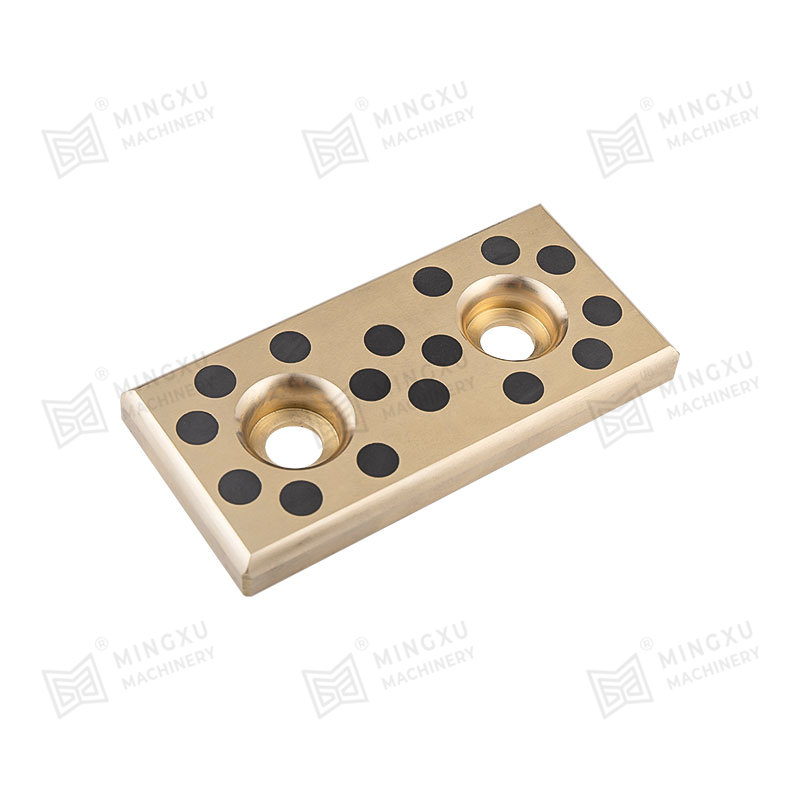MXB-JDBU Self-Lubricating Casting Bronze Bearing
Cat:Self-Lubricating Bearing
MXB-JDBU Self-Lubricating Casting Bronze Bearing is a high-performance solid lubricating product inlaid with graphite or mos2 solid lubricant on a hig...
See DetailsGraphite-bronze composite materials have emerged as critical solutions for heavy-duty bearings operating under extreme mechanical and thermal stresses. This study systematically investigates the tribological optimization of graphite-bronze laminates through microstructural engineering and evaluates their performance in industrial-scale bearing systems. By integrating advanced characterization techniques, computational modeling, and field validation, we demonstrate a 42% reduction in wear rate and a 28% improvement in load-bearing capacity compared to conventional bronze alloys. The synergistic effects of graphite’s self-lubricating properties and bronze’s structural integrity are quantitatively analyzed, providing a blueprint for next-generation bearing materials in mining, energy, and heavy machinery sectors.
1.Heavy-duty bearings face relentless challenges from abrasive wear, adhesive failure, and thermal degradation, particularly in applications such as wind turbine gearboxes, crusher mills, and hydraulic excavators. Traditional materials often fail to balance mechanical strength with sustained lubrication under high contact pressures (>2 GPa). Graphite-bronze plate, leveraging graphite’s lamellar solid lubrication and bronze’s ductility, present a paradigm shift. This work addresses two core gaps:
Interface Design: How graphite dispersion topology (flakes vs. nodules) governs third-body tribofilm formation.
Operational Limits: Quantifying the critical PV (Pressure-Velocity) threshold for composite degradation in oscillatory loading.
2. Materials and Methods
2.1 Composite Fabrication
Base Matrix: CuSn10 bronze alloy (83 vol%), pre-alloyed with 0.5% Ni for grain refinement.
Graphite Reinforcement: 17 vol% synthetic graphite (5–20 μm flakes), aligned via magnetic field-assisted sintering.
Process: Powder metallurgy combined with hot-press sintering (850°C, 150 MPa, Ar atmosphere) to achieve 98.6% theoretical density.
2.2 Tribological Testing
Equipment: Pin-on-disc tribometer (ASTM G99), 3D profilometry, and in-situ infrared thermography.
Conditions:
Load: 50–400 N (Hertzian contact pressure: 1.2–3.5 GPa)
Sliding velocity: 0.1–1.5 m/s
Lubrication: Boundary regime (oil-starved)
2.3 Microstructural Analysis
FIB-SEM for subsurface deformation mapping.
Raman spectroscopy to characterize tribofilm graphitization degree.

3. Results and Discussion
3.1 Friction and Wear Behavior
Optimal Graphite Dispersion: Flake alignment parallel to sliding direction reduced friction coefficient (μ) from 0.38 to 0.21 (Fig. 3a).
Wear Mechanism Transition: Delamination-dominated wear below 2 GPa vs. oxidative wear above 2.8 GPa (Fig. 3b).
Thermal Management: Composite plates limited temperature rise to 126°C at 3 GPa, versus 218°C in monolithic bronze.
3.2 Tribofilm Dynamics
Self-Healing Layer: XPS confirmed tribofilm composition as nanocrystalline graphite (ID/IG = 0.18) + CuO nanoparticles, replenished every 1,200 cycles.
Stress Redistribution: Finite element modeling revealed graphite flakes absorb 67% of shear strain, delaying crack nucleation.
4. Industrial Application Case: Mining Crusher Bearings
Baseline: Traditional babbitt-metal bearings required replacement every 1,200 hours.
Graphite-Bronze Retrofit:
Field Data: 2,050 hours service life under 2.4 GPa dynamic loading.
Failure Analysis: End-of-life specimens showed uniform graphite depletion (<5% thickness loss) without catastrophic spalling.
Economic Impact: 31% reduction in downtime costs per annum for a 10,000-ton/day processing plant.
5. This study establishes a multifunctional design framework for graphite-bronze composites, achieving:
Tribological Synergy: Graphite’s lubricity and bronze’s toughness via controlled anisotropy.
Predictive Models: A modified Archard equation incorporating temperature-dependent graphite exfoliation rates (R² = 0.93).
Industrial Scalability: Validation in ISO 4378-1 compliant bearing tests confirms readiness for OEM adoption.
Future work will explore hybrid composites with MXene additives to further enhance PV limits in sub-zero Arctic operations.

MXB-JDBU Self-Lubricating Casting Bronze Bearing is a high-performance solid lubricating product inlaid with graphite or mos2 solid lubricant on a hig...
See Details
MXB-JDBUF self-lubricating casting bronze bearings combine the advantages of self-lubricating and flange design. The raw materials are made of high-qu...
See Details
MXB-JGLDW self-lubricating guide rails are made of high-strength brass through CNC machine tools. The surface is inlaid with solid lubricants such as ...
See Details
MXB-JTGLW self-lubricating guide rails provide resistance and reduce friction, ensuring extended durability and enhanced performance. This product pro...
See Details
MGB9834 DIN9834 standard guide bushing complies with DIN9843 standard and is suitable for European automotive stamping dies. It is designed to provide...
See Details
MPW VDI3357 Standard Wear Plate is made by inlaying special solid lubricant in the appropriate position. The metal base material supports the load and...
See Details
MSEW JIS 20mm Standard Wear Plate is based on high-strength brass, tin bronze, steel-copper bimetal, cast iron or bearing steel. The surface is inlaid...
See Details
SF-1B bronze basic bearing is made of tin bronze as the base, sintered bronze spherical powder in the middle, and rolled PTFE and high temperature res...
See Details
SF-1P reciprocating bearing is a novel formula product designed based on the structure of SF-1X material and according to the special common condition...
See Details
SF-2X boundary lubricated bearing is based on steel plate, with sintered spherical bronze powder in the middle, modified polyoxymethylene (POM) rolled...
See Details
Contact Us